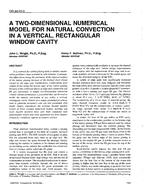Description
It is common for sealed glazing units to exhibit condensation problems when operated in cold climates. Condensation often forms along the perimeter of the exposed surface of the indoor glazing because of the thermal short circuit caused by the edge seal. Furthermore, condensation most readily forms along the bottom edge of the indoor glazing because of the combined effects of edge seal conduction and fill gas convection. A simple two-dimensional numerical control volume formulation is presented that can be used to model the natural convection of gas within a vertical, rectangular cavity. Details of a unique perturbation scheme used to generate secondary cells are also presented. This model closely reproduces the average Nusselt number results of more complex numerical models. Average and local Nusselt numbers have also been compared with experimental results and close agreement has been demonstrated for conditions typical of window cavities.
KEYWORDS: calculating, convection, condensation, windows, double glazing, natural convection, gas, vertical, rectangular, cavities, comparing, Nusselt number, cold regions
Citation: Symposium, ASHRAE Trans. 1994, Vol.100, Part 2
Product Details
- Published:
- 1994
- File Size:
- 1 file , 1.3 MB
- Product Code(s):
- D-17694




